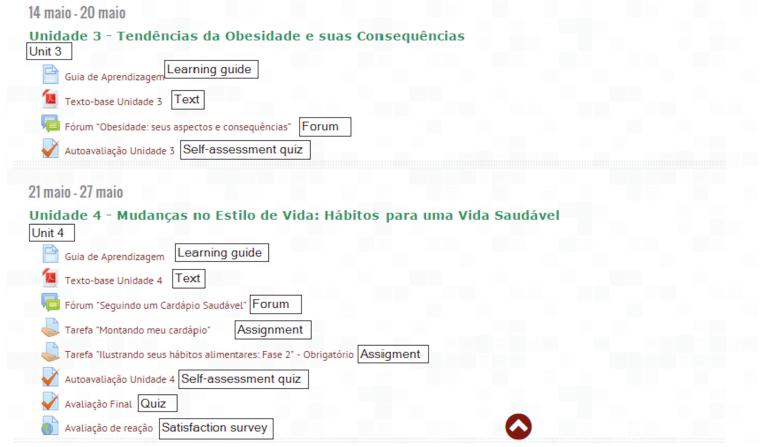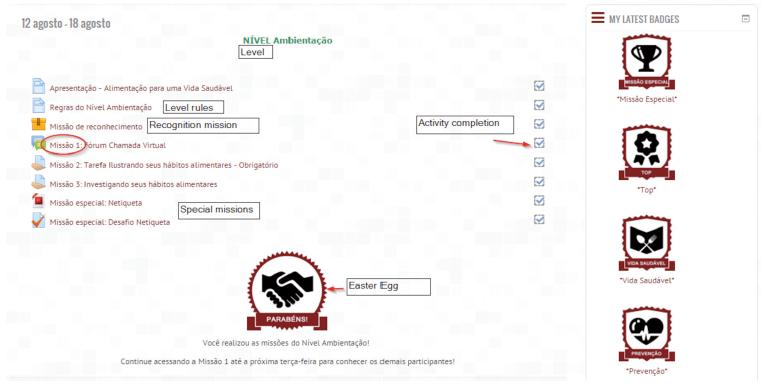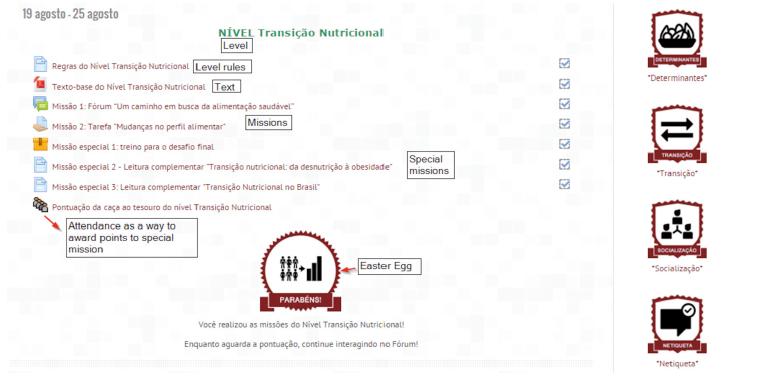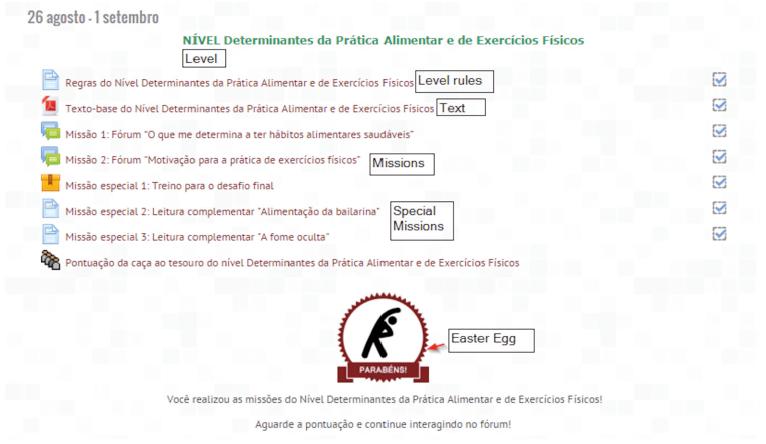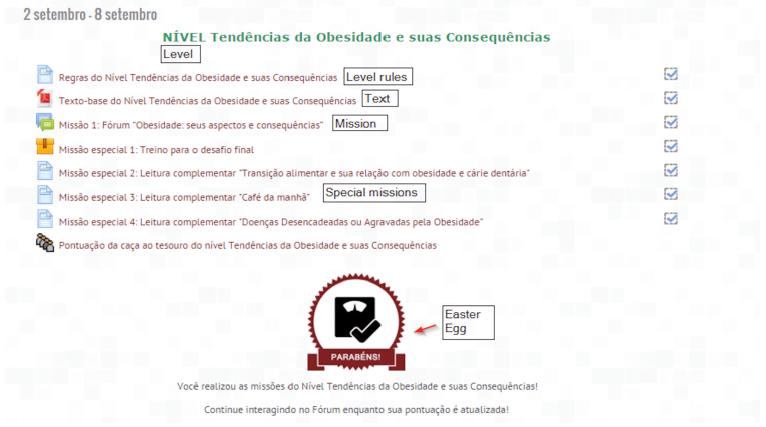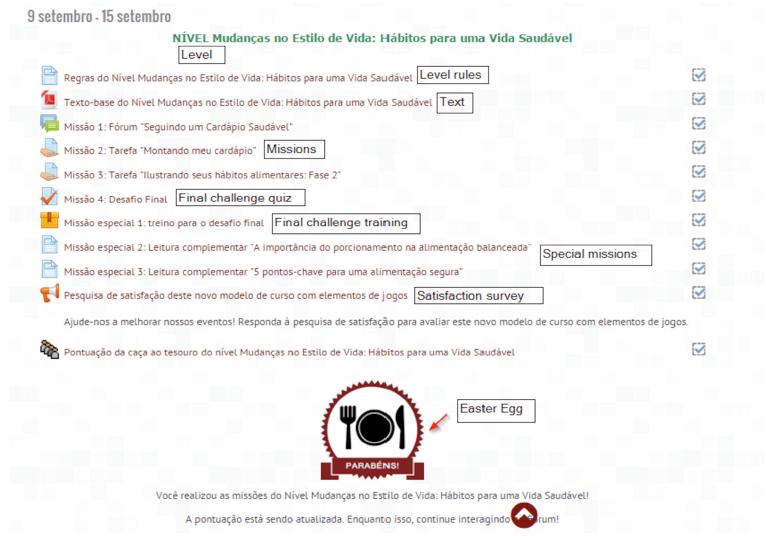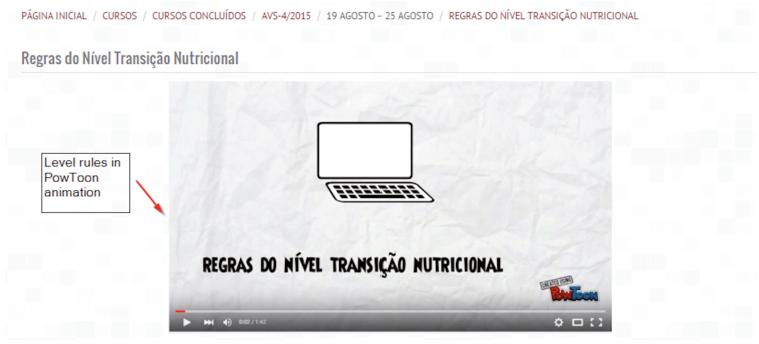Introduction
For thousands of years games have existed in human civilization. Games have been used as simulations (playful simulations by and for children; serious games, as thought-engaging activities for adolescents and adults; joyful activities to socially integrate people, among others), as ways to solve disputes without wasting lives or other resources, and as analytical tools.
With the invention of video games, importance and roles of games have expanded immensely in urban societies, as one can assume from the fact that nowadays the human kind is spending about 3 billion hours a week playing games. Some of these people are connected into a big network of players, by means of which they earn a sense of being part of a global community, whereas some others (and even these same persons, in different moments), feel lonely and bored. (McGONIGAL, 2011)
In learning contexts, affective scenarios are not much different. People tend to sign up for training classes and not attend them due to their experience of feeling lonely and getting bored. Online training tends to be even worse, as it subtracts one of the most liked aspects of traditional training programs: the chance to get out of the office.
It is interesting to note that what we call the traditional way of teaching, or “tell-test education” (PRENSKY, 2001) is less than 300 years old and departures from even more traditional cultural and ethological manifestations of knowledge transmission, based on imitation and procedural coaching; in that sense, the contemporary tendency to focus on mind maps, images in storytelling and several other non-verbal conceptual apparatus, along with the tendency to introduce game dynamics to learning are just a way back to ancient practices that, perhaps, should never have been abandoned.
The ‘epidemics’ of low student motivation and engagement is now recognized as one of the major reasons why such a huge proportion of youngsters do not succeed in school (PRENSKY, 2001; LEE; HAMMER, 2011; SIMÕES; REDONDO; VILAS, 2013). That explains why so many specialists are considering that the advances from information technology, especially when tied to virtual reality (which allows 3D visualization of various structures and complex procedural and declarative learning) should aid the conceptual expansion of learning linear. The idea is not to simply assume that the ability to do a course online instead of in the classroom will do any good to retention; on the contrary, the idea is to assume the failure of type of passive model of information consumption and of a radical form of dichotomy between teachers and students so as to conceive a type of learner-centered conception of knowledge transmission and retention that will create better opportunities to people, while making them happier.
A first step is to critically review the strategies to make things that curriculums assume to be of critical importance memorable; as a rule of the thumb, students will not remember content that is felt as unworthy of remembering, as they will lose the competition with other concurrent content in the neural dynamics that leads to the formation of long term memories.
Before we can advance to a situation where virtual reality will provide a mean to create rich and engaging scenarios for procedural and declarative learning, it is worth considering that the simple use of basic engaging tactics from the video game world may prove to be of value. As we assume, such strategy called ‘gamification’ has the merit to introduce at least one of the powerful mindsets aids that will lead future education: the induction of learning as a process that is independent of meta-cognition; that is, as a process that evolves without the necessity of thinking about what is exactly being learnt at that moment (which is critical in traditional education).
There are several reasons why games, gamification, and simulations are becoming more common that have little to do with the above points: software for game development are becoming cheaper and simpler; socially acceptable age of players went from something like 13 or 14 years old to all ages, especially after the emergence of one of the most hyped new professions of the millennium, the “professional gamer”; companies are adopting a game-oriented culture, both as a way to stimulate employees to associate their brand to subjective experiences of fun (a branding strategy) and as a way to evaluate candidates and personnel.
Some productivity apps should also be mentioned as ‘game changers’ here, as they have helped to resignify some of the most anti-social and pragmatic urban experiences into playful activities. A popular example was given by Waze1, which gamifies traffic and connect people that can track routes and inform the others, for which they receive badges and other forms of rewards. People can also connect with friends and share locations. This is due to the combination of smartphones, mobile web and social media, which changed the way games are played. They became a portable activity. Other popular examples of gamification apps are Nike+ and Zombies, Run which have in common the following attributes: challenge, points, levels, badges and trophies. Some have a social element (status, leaderboards). All of them aim to turn an activity into fun and excitement. (KIM, 2015) 1
All these cases certainly stimulate educators to try gamification techniques, so as to engage their students (KIM, 2015). On the other hand, it is common to hear that this is a typical case of idea that is easier to be debated than to be properly implemented (VRASIDAS; SOLOMOU, 2013). As Challco et al. (2014) state, it is not an easy task for instructional designers to create a gamified course because they have to know how to apply game elements such as leaderboards and point systems as well as game design to combine those elements in a way to maximize motivation and learning. That’s why we believe that a focused discussion on how this should be done is of critical interest.
To our knowledge currently there are two researches about gamification in Moodle (CODISH; RAVID, 2014; PASTOR-PINA et al., 2015) which present tools that can be used to gamify a course in Moodle but not how to insert them in Moodle and implement them in a satisfactory way. Our experience emerges the development of a gamified program for an online training program of a Labour Court in São Paulo, Brazil (TRT-2) where games have never been used. The teaching and learning process follows the socio-constructivist approach and ADDIE model2.
Courses for the court professionals are available in Moodle, an open source learning management system. As all the team members responsible for the creation and implementation of online courses for members and civil servants of TRT-2 are from the educational area, they are always in search of best practices and methods to enhance the effectiveness of the teaching and learning process of students. That led the team to explore different alternatives for online course creation and open source resources, as we will show later, represent important aids in course development.
The aim of this paper is to present our view of how the implementation of gamification in online course should occur, comparing it with our course “Healthy eating for a healthy life”, developed in Moodle without gamification.
Next sections are organized as follows: section 2 presents some findings and theory about elements that can motivate and engage people in learning contexts, among them rewards, immediate feedback, and leaderboards, whereas section 3 shows how these elements can be included in Moodle in a way to contribute positively to the learning experience compared with the framework without gamification.
1 Gamification as a motivational aid
Some people are motivated to learn by ego-gratification and winning; they are satisfied by comparative scores and contests; some people are motivated by pleasure and fun, which are essential to create learner-centered training (PRENSKY, 2001). Gamification, that is, application of video game principles to other domains, motives through both means, so as to stimulate students “to learn, stimulate new skills, and create a fun and interactive learning environment with fewer limitations of time and space in this increasingly informational society.” (KIM; DINU; CHUNG, 2013, p. 63)
To advance the understanding on how gamification can maximize learning, studies have mapped the main educational gamification design principles that are relevant to encourage adherence to the learning purposes: intrinsic and extrinsic motivators (MEKLER et al., 2013; PASTOR-PINA et al., 2015). Intrinsic motivators encourages adherence through the enhancement of the pleasure experienced during the activity, whereas extrinsic motivators enhance adherence as they magnify landmarks and end results of the activity. The former is chiefly represented by perceptions of social engagement, whereas the latter is chiefly represented by feedbacks.
Social engagement is the experience that shared principles and goals drive the behavior of a community that was built and remains in light of the game. As games are often centered around competition, engagement points to social status, which in this context points to the premise that other players consider your achievements in the game, pretty much as if they relate to the outside world. “We want satisfaction of having done something well. Doing something well means doing it better than others.” (HUIZINGA, 1980, p. 63)
Feedback relates to the elements that consolidate learning, by the acknowledgment of achievements and failures. Feedback can come in a form of numerical score, quality assessments and peer commentaries. In the context of gamification, one must bear in mind that feedback must be immediate, corrective and informative, through points, badges and levels. The possibility to get immediate feedback to keep pace in learning is called progressiveness by Pastor-Pina et al. (2015); it is particularly useful for naive learners. In contrast, feedback for experienced learners can be delayed so that they can apply it to more complex behavior.
Some developers of gamification studies and practices (KIM, 2015) recommend the use of leaderboards, which consists of a list of players by their scores or achievements to create an environment for competition. Nevertheless, studies about leaderboards are controversial. Challco et al. (2014, p. 194) indicate that: “a point system that rewards all learners with the same quantity of points for each lesson does not make the learning more enjoyable”, which means that if gamification is not well structured, it can lead to selfish and competitive behaviour instead of cooperation and if it is overdone, it may distract from the purpose. (SPENCER, 2013)
The next section discusses these and other principles, in light of a practical experience with gamification in Moodle 2.5, considering our target audience in TRT-2.
2 Implementation of gamification in Moodle 2.5
Moodle (Modular Object-Oriented Dynamic Learning Environment) is a learning management system (LMS). It is a robust open source interactive learning platform “that helps create effective online teaching and learning experiences in a collaborative, private environment.” (MOODLE, 2015) It was the learning environment chosen by Roque et al. (2013) and Pastor-Pina et al. (2015) due to its popularity among educators. As it is open source, there is a community for support and it can be used in other learning contexts, such as: study groups, teacher training and project development.
Features used to gamify online courses can be: levels, maps to explore the learning, progress bars, shared activities, social uses, instant feedback, points, badges, leaderboards, certificates. Versions 2.5 and superior of Moodle provide the following features: restricted access, activity completion, badges, gradebook, quizzes, assignments, workshops, lessons, surveys, choices, forums and chats. There is also a plugin called progress bar which is a block that shows in colours which activities the student has already completed and which not. (PASTOR-PINA et al., 2015)
We chose to apply structural gamification to the course “Healthy eating for a healthy life”, which had 4 sessions (from April 2014 to April 2015), without gamification and was approved by the target audience in the satisfaction surveys. Therefore, as the course was approved without gamification, its implementation can be a way to maximize learning. This section presents the framework which can be implemented by our team in Moodle 2.5.
“Healthy eating for a healthy life” was created based on the ADDIE model of instructional design. There is a tutor to help and assess students. Content is divided into 5 weeks, being the aim of the first week to give opportunity for students to know each other in the forum and to explore the learning environment. There is a quiz with multiple choice questions (diagnostic assessment) about the content of the whole course, so that students can assess their prior knowledge and what they would learn by the end of the course. Besides that, there is a tutorial and a quiz about etiquette in the internet.
The other four weeks have basically the following structure: a learning guide in which students can check what they are supposed to do during the week and how they are going to be assessed; a pdf file with the content, forums, assignments, and a quiz for self-assessment, which does not count for the final grade. At the end of the course there is also a multiple choice quiz about the content of the whole course, which counts for 10% of the grade. The other 90% is divided among foruns and assignments. Figures 1, 2 and 3 show how the course without gamification was designed.

Source: prepared by the authors.
Figure 1: Layout of online course “Healthy eating for a healthy life” without gamification (dashboard and first week)
As the course was offered in Portuguese, subtitles were included in the original screenshots for reference.
To apply structural gamification to this course the first alteration was in nomenclature. Student was renamed to participant; course presentation to rules; tutor to guru; schedule to missions menu; unit to level; learning guide to level rules; diagnostic assessment to recognition mission; forums and assignments to missions, self-assessment quiz to final challenge training. Activities which did not count for the final grade, such as complementary reading, were renamed to special missions. All these alterations can be seen in Figures 4 to 9.
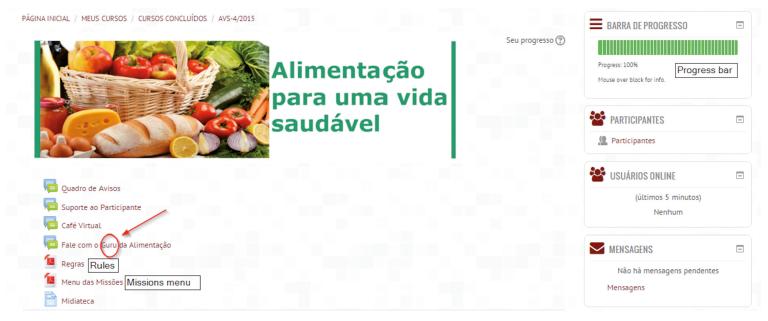
Source: prepared by the authors.
Figure 4: Layout with gamification (dashboard with game nomenclature and progress bar)
On the right-hand side progress bar block was added.
On the right-hand side we added “My Latest Badges” block.
Satisfaction survey was created using Moodle Survey feature so that students cannot answer it anonymously anymore.
Apart from the fixed forums such as notice board and technical support, only the presentation (first activity in Figure 5) is available when the participant is enrolled. All the other activities are blocked until the presentation is viewed.
The presentation and the learning guides were redesigned to animations using PowToon, an online animated presentation software with which all the instructions and learning objectives were voice recorded and presented in the form of animation with a character named Flamínia. The Youtube link3 was embeded in a picture of the animation and displayed as a Page, as shown in Figure 10.
PowToon is user friendly. Difficulties were to get a good headset and a quiet place to record the narration and then get practice to edit the recording. Due to lack of practice it took several hours to finish about 2 minutes of animation.
After participant watches the video, content is unblocked and can be studied in any order he/she decides is the best way for his/her learning process.
We advised in the animation that some activities should be finished before others, but as the target audience are adult learners in an online environment, their freedom of choice must be preserved.
All activities were configured to be tracked so that a blue tick sign would appear in front of the finished ones (example of activity completion can be seen in Figure 5).
Forums and assignments were not altered, except for nomenclature and score system. In previous sessions without gamification, they went from 0-100 points and final grade was the average. The implementation of a score system made it mandatory to change final grade from average to a sum of points. The minimum score to be awarded a certificate of conclusion is 2.701 points, which correspond to 60% of total score of 4.000 points. The guru is responsible for awarding forum and assignments points, therefore, this feedback is not immediate.
For all special missions (which are not compulsory because they are a complement to the course and not basic content) points will be awarded. However, they account for only 5,75% of total score, so even if the participant does not do any of them they can get a high score. Besides that, if the participant decides not to do one or more of the compulsory missions trying to get points from special missions, they will not get a high score and can fail the course.
Digital-game players are used to looking for hidden surprises, known as “Easter Eggs” (PRENSKY, 2001). After completing all the missions, participants get an “Easter Egg”, which is a round shield with an icon related to the level content congratulating them for completing all the missions (examples can be seen in Figures 5 to 9).
The shield was created in the site Makebadg.es4, the icons were downloaded from the site Flaticon5 and were designed with InDesign software. Badges were created in the same way. We added the block Badges to display them.
For Easter Eggs and badges creation the difficulties presented were lack of free icons (without copyright) related to the course content. It took the team a lot of time to find icons that would fit the purpose. Besides, only one member of the team had knowledge of InDesign software.
As rewards should be given to each small accomplishment so that the learner continues motivated (KAPP; BLAIR; MESCH, 2014) there was a badge for finishing all the compulsory activities of each level, a badge for those who finished the internet etiquette activities, a badge for those who finished all the special missions, and a badge for those who finished the course with 3.601 points or more, equivalent to 90% of the total score (all these badges can be in on the right-hand side in Figures 5 and 6). Badges can motivate by being a symbol of status. (ANTIN; CHURCHILL, 2011)
Rewards can be kept as proof of accomplishment, but should not be the reason why learners are playing, the knowledge gained is the most important thing (KAPP; BLAIR; MESCH, 2014). Even though, as badges are going to be awarded for those who got at least 60% of the total score of each level, it is not possible to automatically award them. First the guru will have to award points for missions and then award badges for those who got the minimum score necessary. This feedback is not immediate, which can reduce motivation.
Another feature altered was the self-assessment quiz. In the course without gamification, it was created using Quiz resource from Moodle. In the gamified version, the same multiple choice questions were used in a Storyline 2 Jeopardy-Inspired E-Learning Quiz Template6. It was customized to the needs of our participants and the score system proposed.
After each correct or incorrect answer, participants get immediate feedback, accordingly. It is important to note that in the version without gamification students got immediate feedback only after answering all the questions. Feedback is also auditory, including a sound of applause for correct answer and a sound of moan for incorrect answer. It was renamed to “special mission: final challenge training”. Participants can do multiple attempts (also in the version without gamification it was possible to do it again, but there was no score) and the highest score would be the valid one. See Figures 11 and 12:
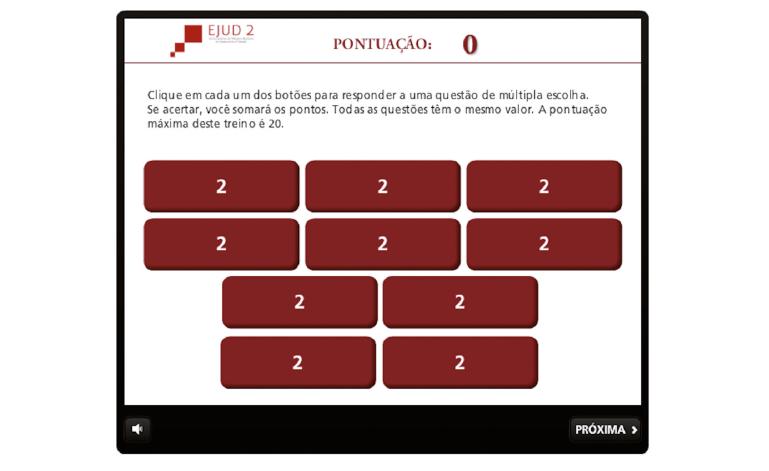
Source: prepared by the authors.
Figure 11: Jeopardy-inspired e-learning quiz created with Storyline

Source: prepared by the authors.
Figure 12: Jeopardy-inspired e-learning quiz created with Storyline (question with immediate feedback)
This special mission is not compulsory but with this game we can track if participants will do it in spite of that.
Regarding the other non compulsory special missions, we hid some Easter Eggs in the middle of the complementary reading7, so that we could track if participants would do this activity in spite of it being non compulsory. There is no way to be sure if they are going to read the whole text or just scan it to click on the pictures, but at least the activity can be tracked.
As the pictures are hidden as orphaned activities and the texts are presented in Pages, in order to count the score for this activity we installed Attendance plugin. This plugin is used to register attendance, but in this case we selected the criteria to “Found Easter Egg” and “Did Not Find Easter Egg”. The guru has to check activity completion and select the option to award points so again feedback is not immediate.
With reference to progress bars and leaderboards, the first could be implemented successfully but not the latter. Progress bar is an easy configurable block. Every activity has to be tracked. Participants and guru see activities in green if they were done, blue if there is still time to finish them and red if deadline was not met. Example in Figure 4 shows a progress bar with all the activities done. Progress bar is an example of immediate feedback regarding activity completion, which does not mean student did it satisfactory.
The Leaderboard plugin did not work in Moodle 2.5. After installing it, additional configuration was necessary and our team did not have access to that. We asked the IT team to do that but even so the leaderboard did not recognised the points awarded during our tests. We had to leave behind this game mechanic because it would be unfeasible to create a non automatic leaderboard every week. This was a drawback for motivation because some participants could use competitiveness to get more engaged.
These were all the features we could include in Moodle 2.5 to gamify a course in order to enhance the teaching and learning process.
3 Conclusion
This paper proposes a framework to apply structural gamification in Moodle 2.5 for online training of members and civil servants from TRT-2. The main conclusions of the work are (1) Moodle 2.5 has the following features to gamify an online course: activity completion, restricted access, progress bar block, badges, score (to add games made with software like Storyline) and gradebook. All the other features can be used to gamify the course if you use your imagination to create fun and playful activities (as the animation video displayed in a Page). If the team responsible for creating online courses has knowledge of development, it is possible to use Moodle documentation to create a gamification block, otherwise, only simple mechanics can be implemented. (2) It takes much time to configure all the features. The Badge block only displays badges, which need to be created. If the team does not have someone able to use graphic software it will be challenging to create worthwhile badges. As a study about gamification design indicated that badges appear in the 5th position as the most attractive gamification feature (HSU; CHANG; LEE, 2013), the team must analyse the cost benefit relationship between time to create badges and the impact of them in the enhancing of student performance. (3) Simple games can be created using Storyline software or similar so that participants can get immediate feedback. This requires from the team a good knowledge of the software and plenty of time and equipment (voice recording to create the animation needed special microphone and a quiet place, as well as a person with knowledge to edit the recording to cut external noises, for example).
The main future work includes the construction of a framework for online courses without tutor. We intend to provide training for the team so that more complex features in Moodle and Storyline can be designed and students can go through the whole content and activities by themselves as they would do if playing a game, with the possibility of failure and immediate feedback to try again, according to what has been mapped by studies (DICHEVA et al., 2015; GORDON; BRAYSHAW; GREY, 2013) about the main educational gamification design principles.














